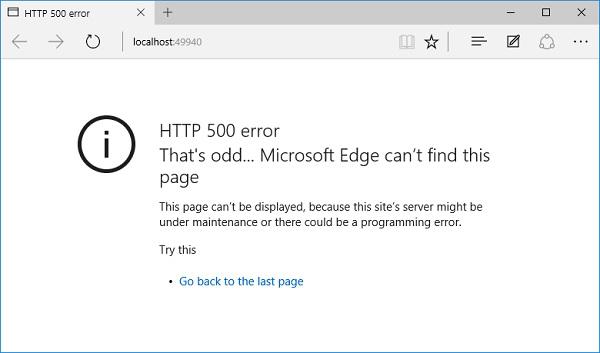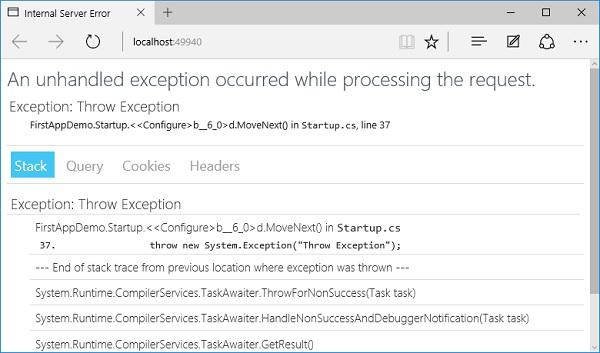ASP.NET Core - Exceptions
In this chapter, we will discuss exceptions and error handling. When errors occur in your ASP.NET Core app, you can handle them in a variety of ways. Let us see an additional piece of middleware that is available through the diagnostics package. This piece of middleware will help us process errors.
To simulate an error, let us go to app.Run and see how the application behaves if we just throw an exception every time we hit this piece of middleware.
using Microsoft.AspNet.Builder;
using Microsoft.AspNet.Hosting;
using Microsoft.AspNet.Http;
using Microsoft.Extensions.DependencyInjection;
using Microsoft.Extensions.Configuration;
namespace FirstAppDemo {
public class Startup {
public Startup() {
var builder = new ConfigurationBuilder()
.AddJsonFile("AppSettings.json");
Configuration = builder.Build();
}
public IConfiguration Configuration { get; set; }
// This method gets called by the runtime.
// Use this method to add services to the container.
// For more information on how to configure your application,
// visit http://go.microsoft.com/fwlink/?LinkID=398940
public void ConfigureServices(IServiceCollection services) {
}
// This method gets called by the runtime.
// Use this method to configure the HTTP request pipeline.
public void Configure(IApplicationBuilder app) {
app.UseIISPlatformHandler();
app.UseRuntimeInfoPage();
app.Run(async (context) => {
throw new System.Exception("Throw Exception");
var msg = Configuration["message"];
await context.Response.WriteAsync(msg);
});
}
// Entry point for the application.
public static void Main(string[] args) => WebApplication.Run<Startup>(args);
}
}
It will just throw an exception with a very generic message. Save Startup.cs page and run your application.

You will see that we failed to load this resource. There was a HTTP 500 error, an internal server error, and that is not very helpful. It might be nice to get some exception information.
Let us add another piece of middleware, which is the UseDeveloperExceptionPage.
// This method gets called by the runtime.
// Use this method to configure the HTTP request pipeline.
public void Configure(IApplicationBuilder app) {
app.UseIISPlatformHandler();
app.UseDeveloperExceptionPage();
app.UseRuntimeInfoPage();
app.Run(async (context) => {
throw new System.Exception("Throw Exception");
var msg = Configuration["message"];
await context.Response.WriteAsync(msg);
});
}
This piece of middleware is a little bit different than the other pieces of middleware, the other pieces of middleware are typically looking at the incoming request and making some decision about that request.
The UseDeveloperExceptionPage doesn't care so much about the incoming requests as it does what happens later in the pipeline.
It is going to just call into the next piece of middleware, but then it is going to wait to see if anything later in the pipeline generates an exception and if there is an exception, this piece of middleware will give you an error page with some additional information about that exception.
Let us now run the application again. It will produce an output as shown in the following screenshot.

Now you will see some information that you would expect if there was an error in development. You will also get a stack trace and you can see that there was an unhandled exception thrown on line 37 of Startup.cs.
You can also see raw exception details and all of this information can be very useful for a developer. In fact, we probably only want to show this information when a developer is running the application.




